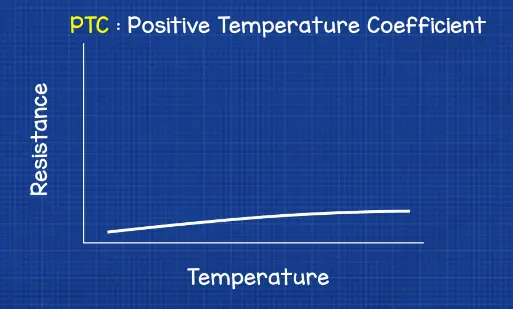PTC thermistors are essential components in the realm of electronics and temperature control. This article will explore their definition, working principles, various types, advantages, limitations, popular applications, and the critical distinctions between PTC thermistors and fuses. Join us on this enlightening journey as we explore the world of these crucial electronic devices.
Part 1. What is a PTC thermistor?
A PTC thermistor, short for Positive Temperature Coefficient thermistor, is a type of resistor that exhibits a significant change in electrical resistance with temperature variations. Unlike conventional resistors, PTC thermistors have a positive temperature coefficient, which means their resistance increases as the temperature rises. This unique characteristic makes them useful in numerous temperature-sensing and control applications.
Part 2. How do PTC thermistors work?
PTC thermistors work based on the behavior of certain semiconductor materials, typically containing barium titanate or other similar compounds. At lower temperatures, these materials have a crystalline structure that allows a relatively free flow of electrons, resulting in low resistance. However, as the temperature increases, the crystal structure changes, restricting the flow of electrons and causing a significant rise in resistance.
This positive temperature coefficient effect enables PTC thermistors to be excellent temperature sensors. By measuring the changes in resistance, it becomes possible to monitor and control temperature-related processes accurately.
Part 3. Types of PTC thermistors
Chip Thermistors:
These PTC thermistors are small, often square or rectangular. Electronic circuits are commonly used for temperature sensing and control.
They are manufactured using semiconductor materials such as barium titanate and exhibit a positive temperature coefficient, meaning their resistance increases with temperature.
Chip thermistors find applications in devices like temperature sensors, heating elements, and overcurrent protection circuits.
Bead Thermistors:
Bead thermistors are typically small, round components encased in a protective material such as glass or epoxy resin.
They are commonly used for temperature measurement in various industries, including automotive, medical, and HVAC systems.
Bead thermistors provide accurate temperature-sensing capabilities; manufacturers often integrate them into probes or sensors for specific applications.
Disk Thermistors:
Disk thermistors are more extensive compared to chip and bead thermistors. They are suitable for applications that require higher power dissipation.
Electronic devices often use them for motor starting, overcurrent protection, and temperature compensation.
Due to their larger surface area, disk thermistors can handle higher currents and power levels, making them suitable for demanding industrial applications.
Glass-Coated Thermistors:
Manufacturers coat these thermistors with a thin layer of glass to protect them against environmental factors like moisture, chemicals, and mechanical stress.
Glass-coated thermistors are commonly used in harsh environments where temperature-sensing accuracy and reliability are crucial.
They are applicable in automotive, aerospace, and industrial automation industries, where the sensors face exposure to extreme conditions.
Surface Mount Thermistors:
Surface mount thermistors are designed for easy integration onto printed circuit boards (PCBs) using surface mount technology (SMT).
They come in various package sizes and shapes, allowing for flexibility in design and placement on PCBs.
Surface mount thermistors are widely used in consumer electronics, telecommunications, and industrial equipment for temperature sensing and control.
Probe Thermistors:
Probe thermistors consist of a sensing element encapsulated within a metal or plastic housing, often with a pointed tip for insertion into liquids, gases, or solids.
They are used in accurate temperature measurements for food processing, HVAC systems, and scientific research applications.
Probe thermistors offer fast response times and high accuracy, making them suitable for industrial and laboratory environments.
Part 4. PTC thermistor advantages and limitations
Advantages:
- Temperature Sensing Accuracy: PTC thermistors offer precise temperature sensing capabilities, allowing for accurate monitoring and control of temperature-sensitive systems.
- Fast Response Time: These thermistors exhibit rapid response to changes in temperature, making them ideal for applications where quick detection and action are required.
- Self-Regulating Properties: PTC thermistors have a positive temperature coefficient, meaning their resistance increases with temperature. This self-regulating behavior helps prevent circuit overheating by limiting current flow as temperature rises.
- Wide Operating Temperature Range: PTC thermistors can operate effectively across a broad temperature range, from sub-zero to several hundred degrees Celsius, making them suitable for diverse applications.
- Reliability and Durability: With proper design and handling, PTC thermistors can be highly reliable and durable components, capable of withstanding harsh environmental conditions and mechanical stress.
Limitations:
- Nonlinear Response: PTC thermistors exhibit a nonlinear resistance-temperature relationship, which can complicate calibration and measurement in some applications.
- Limited Operating Voltage: These thermistors have a maximum voltage rating beyond which they may experience thermal runaway or permanent damage. Careful consideration of voltage levels is necessary to prevent overloading.
- Temperature Hysteresis: PTC thermistors may exhibit temperature hysteresis, meaning their resistance values can vary slightly depending on whether the temperature increases or decreases. This characteristic requires careful calibration in specific applications.
- Sensitivity to Environmental Factors: PTC thermistors can be sensitive to environmental factors such as humidity, pressure, and vibration, which may affect their performance and reliability.
- Manufacturing Variability: Variations in manufacturing processes and materials can lead to differences in performance and characteristics among PTC thermistors, requiring tighter quality control measures for consistent results.
- Limited Current Handling Capacity: While PTC thermistors can provide overcurrent protection, they have limitations on how much current they can handle before entering the high-resistance state, which may not be suitable for high-power applications.
Part 5. Applications of PTC thermistors
The versatility of PTC thermistors enables their utilization in various applications across different industries. Some notable applications include:
Temperature Sensing and Control: PTC thermistors are widely used in thermostats, HVAC systems, refrigerators, and other devices that require precise temperature control.
Overcurrent Protection: Switching PTC thermistors are employed as self-resetting fuses in electronic circuits to safeguard against overcurrent and short circuits.
Motor Starters: PTC thermistors are utilized in motor starter circuits to provide inrush current protection and prevent damage to the motor.
Heating Elements: Heating PTC thermistors are commonly found in electric heaters, hair dryers, and automotive seat heaters, where they efficiently convert electrical energy into heat.
Part 6. What is the difference between a PTC thermistor and a fuse?
|
Aspect |
PTC Thermistor |
Fuse |
|
Operation |
A PTC thermistor operates by changing its resistance in response to changes in temperature. When the temperature increases beyond a certain threshold, the resistance of the PTC thermistor rises sharply, limiting the current flow through the circuit. |
A fuse breaks the circuit when the current exceeds a predetermined threshold. When excessive current flows through the circuit, the fuse wire melts, opening the circuit and preventing damage to the connected components. |
|
Resettable |
PTC thermistors are resettable devices that return to their original low-resistance state once the temperature decreases below the threshold level. This allows them to provide overcurrent protection repeatedly without needing replacement. |
/ |
|
Non-Resettable |
/ |
Fuses are non-resettable devices; once blown and interrupted, the circuit must be replaced to restore functionality. They do not return to their original state after the fault condition is resolved. |
|
Response Time |
PTC thermistors typically have fast response times, reacting quickly to changes in temperature and limiting the current flow almost instantaneously. |
Fuses have relatively slower response times than PTC thermistors, as they rely on the heating effect of current flow to melt the fuse wire. |
|
Usage |
They are commonly used for overcurrent protection in electronic circuits, battery packs, and motor starting applications. |
Fuses are commonly used for overcurrent protection in electrical systems, power distribution panels, and appliances. |
Part 7. FAQs
-
What is the difference between RTD and PTC?
RTD (Resistance Temperature Detector) measures temperature by changes in resistance due to temperature fluctuations, usually made of metals like platinum. On the other hand, PTC (Positive Temperature Coefficient) thermistors also measure temperature by resistance changes but use semiconductor materials like barium titanate. -
What is the characteristic of a PTC thermistor?
PTC thermistors exhibit a positive temperature coefficient, meaning their resistance increases with rising temperature. This characteristic enables them to self-limit current flow in circuits, making them useful for overcurrent protection, temperature sensing, and motor starting applications. -
Why use NTC instead of PTC?
NTC (Negative Temperature Coefficient) thermistors have a resistance that decreases as temperature rises, making them suitable for temperature sensing in a broader range of applications, such as temperature compensation, temperature measurement, and inrush current limiting. -
Why is NTC preferred over PTC?
NTC thermistors are preferred over PTC in many applications due to their more comprehensive operating temperature range, lower cost, and ease of integration into electronic circuits. They offer greater flexibility and sensitivity in temperature measurement and control systems than PTC thermistors.
Related Tags:
More Articles

Safe Charging Protocols for Your 11.1V LiPo Battery Charger
Safely charge your 11.1V LiPo battery by following proper rates, using safety tools, and avoiding common charging mistakes.
11.1 V LiPo Battery Airsoft: Boosting Field Performance
Upgrade your airsoft gun with an 11.1V LiPo battery for faster firing, longer runtime, and top-tier performance on the battlefield.
Batteries for Trolling Motors Lightweight vs. Leaf Blower Power
Explore the best lightweight trolling motor batteries and how they compare to leaf blower power for performance, portability, and runtime.
What Is a 2C Battery?
Learn what a 2C battery is, how C-rates affect performance, and how to calculate the number of batteries your device needs.
What Battery Does LED Strips Use?
Discover which batteries power LED strips best. Learn about voltage, capacity, battery types, and how to safely power your LED lighting projects.




